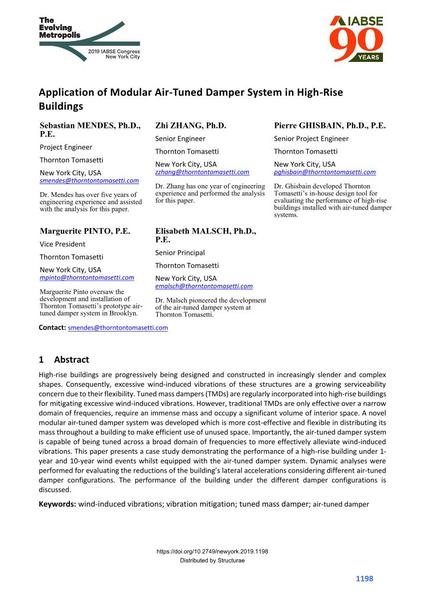Application of Modular Air-Tuned Damper System in High-Rise Buildings

|
|
|||||||||||
Bibliografische Angaben
| Autor(en): |
Sebastian Mendes
(Thornton Tomasetti)
Zhi Zhang (Thornton Tomasetti) Pierre Ghisbain (Thornton Tomasetti) Marguerite Pinto (Thornton Tomasetti) Elisabeth Malsch (Thornton Tomasetti) |
||||
|---|---|---|---|---|---|
| Medium: | Tagungsbeitrag | ||||
| Sprache(n): | Englisch | ||||
| Tagung: | IABSE Congress: The Evolving Metropolis, New York, NY, USA, 4-6 September 2019 | ||||
| Veröffentlicht in: | The Evolving Metropolis | ||||
|
|||||
| Seite(n): | 1198-1203 | ||||
| Anzahl der Seiten (im PDF): | 6 | ||||
| DOI: | 10.2749/newyork.2019.1198 | ||||
| Abstrakt: |
High-rise buildings are progressively being designed and constructed in increasingly slender and complex shapes. Consequently, excessive wind-induced vibrations of these structures are a growing serviceability concern due to their flexibility. Tuned mass dampers (TMDs) are regularly incorporated into high-rise buildings for mitigating excessive wind-induced vibrations. However, traditional TMDs are only effective over a narrow domain of frequencies, require an immense mass and occupy a significant volume of interior space. A novel modular air-tuned damper system was developed which is more cost-effective and flexible in distributing its mass throughout a building to make efficient use of unused space. Importantly, the air-tuned damper system is capable of being tuned across a broad domain of frequencies to more effectively alleviate wind-induced vibrations. This paper presents a case study demonstrating the performance of a high-rise building under 1- year and 10-year wind events whilst equipped with the air-tuned damper system. Dynamic analyses were performed for evaluating the reductions of the building’s lateral accelerations considering different air-tuned damper configurations. The performance of the building under the different damper configurations is discussed. |
||||
